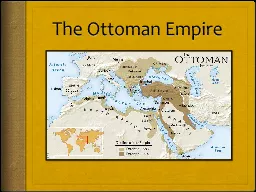

Southwest Asia and the Indian Ocean 1 The Ottoman Empire a This empire was founded around 1300 b Extended Islamic conquests into eastern Europe c Was more similar to monarchs in France and Spain than Islamic Caliphates ID: 466079
Download Presentation The PPT/PDF document "The Ottoman Empire" is the property of its rightful owner. Permission is granted to download and print the materials on this web site for personal, non-commercial use only, and to display it on your personal computer provided you do not modify the materials and that you retain all copyright notices contained in the materials. By downloading content from our website, you accept the terms of this agreement.
Slide1
The Ottoman EmpireSlide2
Southwest Asia and the Indian Ocean
1. The
Ottoman Empire
a. This
empire was founded around
1300
b. Extended Islamic conquests into eastern Europe
c. Was
more similar to monarchs in France and Spain than Islamic CaliphatesSlide3
Southwest Asia and the Indian Ocean
2
.
Expansion and Frontiers
a.
Three factors for major growth
i
. The
shrewdness of its founded
Osmam
and his descendants
ii. Control
of a strategic link between Europe and Asia at Gallipoli on the Dardanelles strait
iii. The
creation of an army that took advantage of the traditional skills of the Turkish cavalryman and the new military possibilities presented by gunpowderSlide4
Southwest Asia and the Indian Ocean
b. At
first, Ottoman armies concentrated on Christian enemies in Greece and the Balkans
c. They
then wanted to capture the Byzantine capital of Constantinople
i
. In
1453, the city was captured thanks to new gunpowder technology
ii. Constantinople
then became
IstanbulSlide5
Southwest Asia and the Indian Ocean
d
. Suleiman
the Magnificent
i
. Ruled
during the “golden age” of Ottoman imperial power
ii. Conquered
many European cities
iii. Unable to conquer Vienna due to the weatherSlide6
Southwest Asia and the Indian Ocean
e. Between
1453 and 1502, the Ottomans fought the opening rounds of a two-century war with Venice in Italy
i
. The
Ottomans wanted power over of valuable trade routes that the Italians controlled
ii. Venice
forced to pay tribute to the Ottomans but remained a sea empire
f. Tried
to stop the spread of Portuguese trade in the Middle East by limiting their influence to the coastal cities Slide7
Southwest Asia and the Indian Ocean
3. Central
Institutions
a. Army
consisted of lightly armored mounted warriors skilled at shooting a short bow
b. Christian
prisoners of war were forced to serve as military slavesSlide8
Southwest Asia and the Indian Ocean
i
. These
troops converted to Islam and were called Janissaries
ii. This
practice was not necessarily legal according to Islamic law
iii. These
soldiers had no problems fighting Turks and Muslims in Western AsiaSlide9
Southwest Asia and the Indian Ocean
iv
. Did
not have the same horse/bow background, fought on foot and with guns
v. These
Janissaries were barred from marriage or holding other jobsSlide10
Southwest Asia and the Indian Ocean
c. In
the early 15
th
century, the selection process for Janissary training changed and the new system was called
devshirme
(selection)
i
. This meant that children were taken from Christian villages and placed in Turkish homes to learn their languageii. They were then sent to Istanbul to be trained in Islam, warfare, etc.
iii. This
system produced many military commanders and heads of government departmentsSlide11
Southwest Asia and the Indian Ocean
d. The
Ottoman Empire was the most powerful and best-organized state in either Europe or the Islamic world during the rule of Suleiman the Magnificent
e. The
Ottoman conception of the world saw the sultan providing justice for his “flock of sheep” (
raya
) and the military protecting them
f. In
return, the
raya paid the taxes that supported both the sultan and the militarySlide12
Southwest Asia and the Indian Ocean
D. Crisis
of the Military State (1585-1650)
i
. More
emphasis placed on Janissary corps and guns, less on the Turkish cavalry, leading to the need to collect more money to pay for these guns
ii. An
influx of silver from the new world further weakened the position of the land-owning cavalry soldiersSlide13
Southwest Asia and the Indian Ocean
iii. Between
1590 and 1610 there were revolts by former land-holding cavalrymen, short-term soldiers released and out of work, peasants overburdened with emergency taxes, and even impoverished students of religion
iv. Janissaries
took advantage of the situation to gain the ability to participate in business and marrySlide14
Southwest Asia and the Indian Ocean
5. Economic
Change and Growing Weakness (1650-1750)
a. After
this time of crisis, the Ottoman Empire was very different
i
. The
sultan mostly resided in his palace and had little experience of the real world
ii. Janissaries
corps membership was now hereditaryiii. Land
grants in return for military service also disappeared
b. Ottoman
military continued to decline
Janissaries
sometimes resorted to hiring substitutes to go on campaignSlide15
Southwest Asia and the Indian Ocean
c. The
Ottoman Empire lacked both the wealth and inclination to match European economic advances
d. The
Tulip Period
lasted from 1718 to 1730 and was so named because of the craze for high priced tulip bulbs that swept Ottoman ruling circles
i
. The
Ottomans did not see Europeans as a threat to their power and actually borrowed their furniture and clothing styles